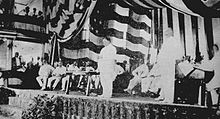This article is missing information about the composition, powers, organization, and actions of the Assembly. It needs to be expanded beyond its creation and first election. (June 2013) |
Philippine Assembly | |
|---|---|
| Type | |
| Type | |
| History | |
| Founded | October 16, 1907 |
| Disbanded | October 16, 1916 |
| Preceded by | Philippine Commission |
| Succeeded by | House of Representatives of the Philippines |
| Seats | 80[1] |
| Meeting place | |
| Manila Grand Opera House | |


The Philippine Assembly (sometimes called the Philippine National Assembly) was the lower house of the Philippine Legislature from 1907 to 1916, when it was renamed the House of Representatives of the Philippines. The Philippine Assembly was the first national legislative body fully chosen by elections.
The Assembly was created by the 1902 Philippine Organic Act of the United States Congress, which established the Insular Government of the Philippines. Along with an upper house (the appointed Philippine Commission), it formed the bicameral Philippine Legislature during the American colonial period.[2] In 1916, the Jones Act replaced the Philippine Organic Act and the Assembly became the current House of Representatives of the Philippines.
The first Philippine Assembly elections were held on July 30, 1907.[3] These were the first nationwide elections ever held in the Philippines. The Assembly was inaugurated on October 16, 1907 with Sergio Osmeña as Speaker of the Assembly, Manuel L. Quezon as majority leader, and Vicente Singson as minority leader.[3]
The inauguration of the assembly marked a "turning point in the country’s history, for its creation marked the commencement of Filipino participation in self-governance and a big leap towards self-determination."[4]
- ^ "The History of the First Philippine Assembly (1907–1916)". National Historical Commission of the Philippines. September 5, 2012.
- ^ Robertson, James Alexander (July 1917). "The Philippines since the Inauguration of the Philippine Assembly". The American Historical Review. 22 (4): 811–830. doi:10.2307/1836242. JSTOR 1836242.
- ^ a b National Historical Commission Of The Philippines | Republika Ng Pilipinas
- ^ Piedad-Pugay, Chris Antonette. "The Philippine Bill of 1902: Turning Point in Philippine Legislation". The National Historical Commission of the Philippines. Retrieved January 5, 2014.
